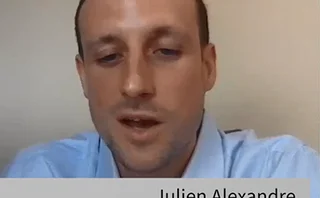
Shaking things up in the dark: Vendors build new tools for dark-pool trading in Asia-Pacific
New conditional order venues could bring more liquidity and sophistication to dark pool trading in the region.
Dark trading in Asia-Pacific is still relatively minimal compared with the US and Europe. In Hong Kong, for example, turnover in dark pools represented between 1% and 1.7% of total market turnover from October 2016 to September 2017, according to data from Hong Kong Exchanges and Clearing. Dark volumes in Europe and the UK stood at around 9% in 2020, while in the US, by some estimates, dark pools capture between 40% and 50% of average daily market share on some days.
A big reason for this discrepancy in volumes is market structure and the nature of retail trading in Asia-Pacific, says the head of equities for Asia at a New York-based investment bank. In China, for example, block trades—which are popular orders for dark trading in the US—can only be done in a 30-minute window before the market closes. This is partly because the region is more conservative and investors are more oriented toward lit market strategies. Furthermore, the head of equities says, several regional markets have high retail participation in stock markets overall, which is good for market participants because it creates a more diverse order book and “stickier” liquidity, so using dark pools to execute block trades isn’t as necessary as it is elsewhere.
“In the very liquid stuff, say you have a block of [Chinese tech giant] Tencent—you don’t really need to find the other side. You just throw it in the market and it gets done in 10 minutes,” the head of equities says. But illiquid stocks present a greater challenge: “If you’re trading something that really needs crossing, it’s a small chance you’ll find the other side also trading. Often, when you want to buy, you find that everybody else is a buyer. It’s just a very directional market.”
This is where technology can play a significant role in dark pools, as it offers the ability to mask pre-trade information, according to a managing director at an institutional broker-dealer. “If you rest a large order in a dark pool, you can’t see the order resting in that order book. This is different from what you would see on a standard exchange order book. That innovation has been around for some time, but it’s important as it means no pre-trade information is published to the market, and that means it reduces information leakage,” the managing director says.
Moreover, microstructure improvements to dark pools, such as conditional orders where clients can apply an “If I could, I would” type of order, as well as the use of minimum quantities, help clients get “chunkier” executions.
The managing director says the buy side might apply a minimum quantity to resting orders. “For example, if you were putting a large order into a dark block venue—say 1 million shares—you might apply a minimum quantity that says you will only accept orders of 25,000 shares or more to execute,” they say.
This means the investor is getting chunkier executions, but it also protects them from interacting with so-called “shrapnel-type orders,” which are essentially small orders. And in markets like Japan, where orders might be from high-frequency trading participants who are usually trading in smaller sizes, institutional users would want to apply a minimum quantity to their orders to filter out interactions with those smaller orders.
Conditional changes
New block-crossing networks and order types entering Asia-Pacific could help dark pool trading grow in the region, necessitating the deployment of new technology.
Agency broker Instinet recently launched BlockMatch Asia, an alternative liquidity pool for non-display equities trading. BlockMatch Asia is a rebranding of CBX Hong Kong, which has two order books: a limit-crossing book and a market-on-close book. With the rebrand, Instinet also added a conditional book for the submission and management of conditional orders.
Within BlockMatch Asia, conditional orders can match at the mid-point price of the primary exchange, allowing users to save half the bid–offer spread. This could be beneficial in markets like Hong Kong, where bid–offer spreads can average 12 basis points.
“If clients are coming through, say, an Instinet algorithm, they will inject an order into the BlockMatch Asia conditional book. Where the conditional book has contra liquidity, a message is then sent back to both users. The algorithm manages the processing of that message, and the processes around sending an order to execute in the venue,” says Ian Lauder, head of liquidity strategy for Asia-Pacific at Instinet.
In contrast, manual conditional orders—also known as blotter scraping—allow buy-side clients to select orders sitting in their blotter and expose them to conditional order venues. When the venues identify a trading opportunity, it sends a message back to the manual user, normally a buy-side trader sitting at their desk.
For manual blotter scraping orders, Instinet has two solutions. “One is blotter scraping through our Newport EMS functionality, which is currently available in Europe today and will be deployed in Asia-Pacific in the coming months,” Lauder says. “Second, later in the year, we expect to roll out BlockCross, with its blotter scraping service in Asia-Pacific. BlockCross is operational today in the US, Canada, and Europe.”
The benefits of using electronic algo conditionals, as opposed to manual, are that they allow clients to integrate large-sized liquidity-seeking into low-touch algorithmic workflows. Blotter scraping, Lauder says, allows for humans at a desk level to interact with the service without their order leaving their blotter, or being visible, which encourages the submission of larger order sizes.
“BlockMatch Asia is also open to other sell-side firms that may route orders into our pool. So we may have other brokers routing conditional block-sized orders into our pool as well,” he says.
And then there were two
With this new order book, Instinet is now the second in the region to offer inbound conditional orders, joining Virtu Financial, which started offering conditionals about two years ago.
“Having more venues offer conditional order types doesn’t come as a threat to Virtu; on the contrary, it is actually what we are helping to promote. We hope that the industry will continue adopting conditional order types as quickly and as broadly as possible,” says Rhys Pinna-Griffith, an executive in execution services for Virtu.
In fact, Virtu and Instinet are currently working to establish connectivity between their respective order routers and conditional order venues. “To achieve optimal execution, our algorithms need to connect to as many venues as possible. Ultimately, our primary objective is to access liquidity on our clients’ behalf, regardless of where that liquidity resides,” Pinna-Griffith says.
He says Virtu will look to replicate this with all other venues that will allow Virtu’s algorithms to access them. “Fragmenting the market and limiting participants does not serve the execution objectives of our underlying clients,” he says.
The key is improving user experience, says Abhishek Janaki, head of liquidity sourcing for Asia-Pacific at Virtu. About two years ago, Virtu made significant enhancements to Posit Alert, its global block-indications network that delivers liquidity from 38 countries daily, including improvements to both Posit Alert’s front-end and back-end technologies that improved the application’s ease of use and reduced performance latencies.
“We delivered technological enhancements that led to a product that was better aligned with client expectations: easy to use, fast, and transparent,” Janaki says.
Looking ahead, Virtu is continuing its tech investment in the Posit Alert platform, which will include a complete rebuild of the back-end and front-end technologies supporting the platform.
In November 2018, Virtu acquired agency broker ITG for $1 billion, which closed in March the following year. In addition to Posit Alert, over the past year in Asia-Pacific, Virtu has been migrating legacy ITG algorithm clients onto its global execution algorithmic platform, Frontier. Phil Chevalier, co-head of execution services for Asia-Pacific at Virtu, says client migrations from the legacy ITG infrastructure to Virtu’s Frontier platform are now 75% to 80% complete. “Our focus this year is to introduce Virtu’s algo stack to our clients and the trading community,” he says.
Pinna-Griffith says the advantage of Frontier is that the Virtu technology stack, which was built over the past 10 years, supports both the company’s market-making and agency algorithms. “For our agency clients, we leverage Virtu’s core technological platform to create agency algorithms that run as completely separate instances from the market-making unit, but get all the advantages of the platform that Virtu’s market-making team uses to develop their strategies,” he says.
Virtu has a dedicated development and research team in Singapore tasked with creating and enhancing the firm’s Asia-Pacific agency algos. “Having the team located in Singapore enables our developers to focus on advantageous opportunities presented by the region’s unique market microstructure and inculcate these into our algorithmic design. Additionally, they interface directly with our Asia-Pacific client base, which has proven invaluable to enhancing the product offering,” Pinna-Griffith says.
Battle stations
Then there’s the incumbent Liquidnet, which interdealer broker TP Icap acquired in October 2020. Liquidnet could soon see challenges to its status as the largest block-crossing network in Asia-Pacific—where it is active in 13 markets—as new entrants look to shake up the dark pool market.
Liquidnet offers a full-service dark pool, meaning it has trade coverage personnel that help users consummate the matches that occur within its systems, says Tristan Baldwin, Asia-Pacific head of equities at Liquidnet. “We have a product that feeds on directly from our initial block execution. So, for instance, target invitations allow clients to seek further block liquidity after they’ve essentially taken all the opportunity out of our pool electronically.”
Liquidnet also walks its clients through the liquidity profiles in its pool, how to access them, and whether it makes more sense to go through its client-to-client negotiated space, or to use an algo to access that dark liquidity.
This is where Baldwin believes Liquidnet has an advantage, as it can see orders that are not sent. Other operators can only see orders once they are submitted to the dark pool. But competition is coming.
Apart from Instinet’s BlockMatch Asia, market participants can expect Cboe Global Markets to also bring its offerings to the region.
In January 2021, Cboe completed its acquisition of Bids Trading, the largest independent block trading alternative trading system (ATS) in the US. Then in June 2021, Cboe finalized its deal to buy Chi-X Asia-Pacific, which it plans to integrate with Bids in both the Australian and Japanese markets.
Liquidnet’s Baldwin says market participants should be wary of a sudden jump in the number of providers in the region. “It can fragment an already difficult liquidity proposition in Asia because it’s not easy to find block-size liquidity,” he says, although it should be noted that Liquidnet certainly has a dog in this race.
And unsurprisingly, others—who have their own motivations—believe competition will add more unique liquidity. The broker-dealer managing director believes that having more conditional or dark providers in markets like Hong Kong that enable customers to execute large blocks will help grow the market. “With more providers comes more choice, and hopefully more familiarity for buy-side clients of these types of mechanisms, because there are more people speaking to them about that,” they say.
Asked about potential competition in the region from Cboe’s Bids and Instinet’s BlockMatch and BlockCross offerings, Baldwin says he anticipates that some of the large regional investment banks and brokers will send outbound liquidity beyond their own crossing networks to dark pools.
“As they’re looking at their strategy of connectivity to the likes of Cboe Bids in Australia and Japan markets only, they will also be looking at how they can access Liquidnet, which is very interesting for market structure going forward,” he says. “Because the advent of increased competition in the block space is really what’s driven these brokers to look more beyond their own four walls.”
Further reading
Only users who have a paid subscription or are part of a corporate subscription are able to print or copy content.
To access these options, along with all other subscription benefits, please contact info@waterstechnology.com or view our subscription options here: http://subscriptions.waterstechnology.com/subscribe
You are currently unable to print this content. Please contact info@waterstechnology.com to find out more.
You are currently unable to copy this content. Please contact info@waterstechnology.com to find out more.
Copyright Infopro Digital Limited. All rights reserved.
As outlined in our terms and conditions, https://www.infopro-digital.com/terms-and-conditions/subscriptions/ (point 2.4), printing is limited to a single copy.
If you would like to purchase additional rights please email info@waterstechnology.com
Copyright Infopro Digital Limited. All rights reserved.
You may share this content using our article tools. As outlined in our terms and conditions, https://www.infopro-digital.com/terms-and-conditions/subscriptions/ (clause 2.4), an Authorised User may only make one copy of the materials for their own personal use. You must also comply with the restrictions in clause 2.5.
If you would like to purchase additional rights please email info@waterstechnology.com
More on Market access
Hunting for reliable low latency, HFTs look to novel techs in 2023
WatersTechnology looks at advancements in market data latency technology and what role the cloud can play.
Managing the FX challenge for T+1
As firms prepare for T+1 in May 2024, DTCC’s Val Wotton says they should also consider the complexities for cross-border trades.
ASX, SGX earnings driven by diversified revenue
After the Chess disaster, ASX focuses on rebuilding confidence, while SGX continues investing in its derivatives business. Meanwhile, HKEx mulls data play.
Shall we compare thee to a multilateral trading venue?
As regulators confirm that perimeter guidance applies to tech firms, the focus shifts to enforcement.
IMD & IRD Awards 2023 winner's interview: MarketAxess
MarketAxess won the best AI/machine learning data initiative in this year’s Inside Market Data & Inside Reference Data Awards, thanks to its CP+ bond pricing engine.
No big boost to UK dark trading after Brexit
Expected explosion in hidden equity liquidity has failed to materialize
Competing CTPs won’t work, warn EU firms, calling for single tape provider
As the industry awaits upcoming EC proposals, some firms are voicing concerns that mandating multiple CTPs could create fresh problems around data fragmentation and connectivity costs.
This Week: Bloomberg/Goldman Sachs, Broadridge, Rimes, and more
A summary of some of the past week's financial technology news.








